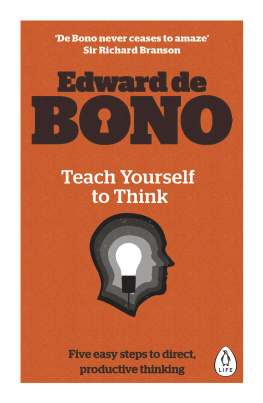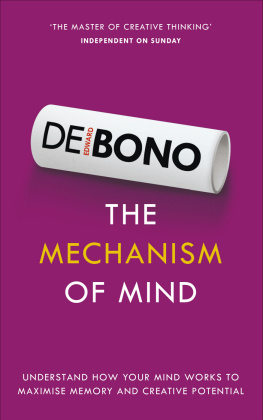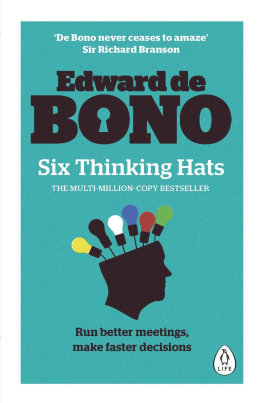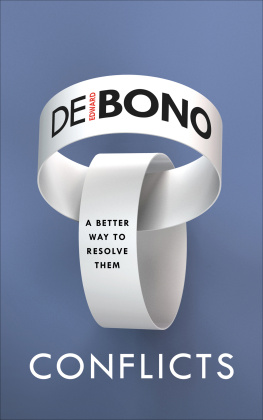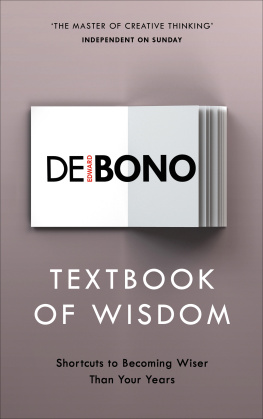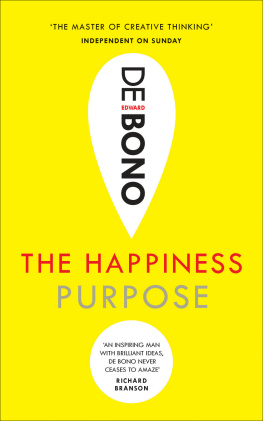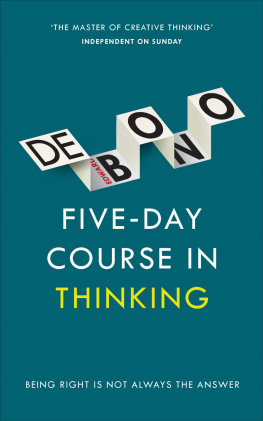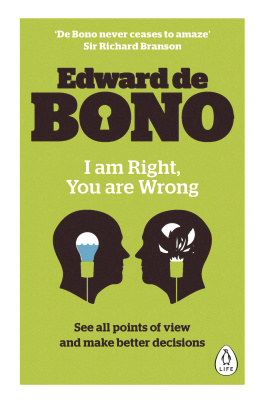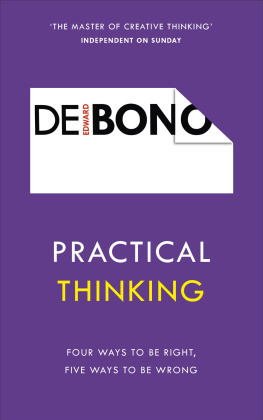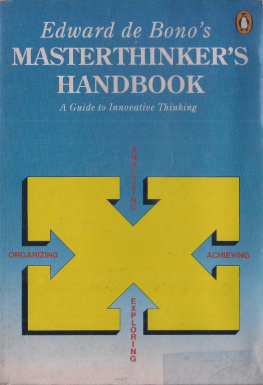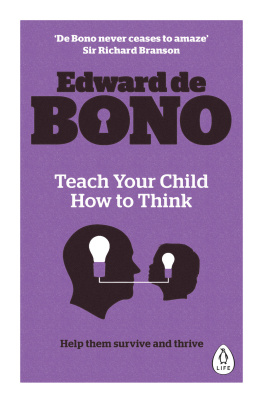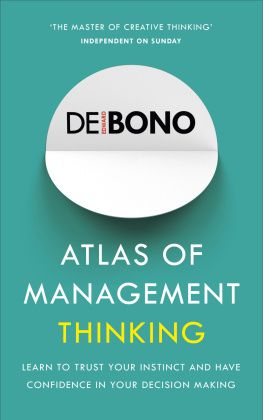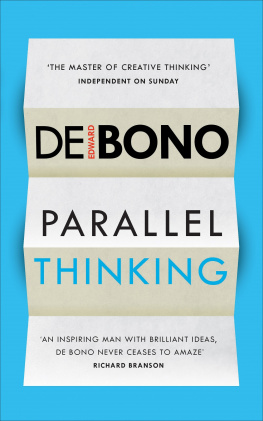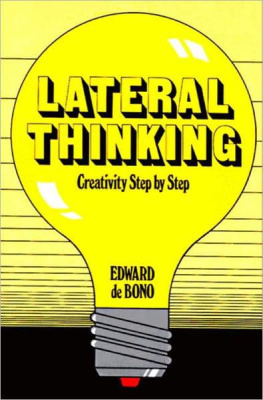Contents
Edward de Bono
TEACH YOURSELF TO THINK
PENGUIN LIFE
UK | USA | Canada | Ireland | Australia
India | New Zealand | South Africa
Penguin Life is part of the Penguin Random House group of companies whose addresses can be found at global.penguinrandomhouse.com.
First published by Viking 1995
Published in Penguin Books 1996
Published in Penguin Life 2015
Copyright IP Development Corporation, 1995
The moral right of the author has been asserted
Cover Design: Dan Mogford
Edward de Bono hereby asserts his moral right to be known as the author of this work. For more information about training in Dr de Bonos method, see www.debono.com
Notice: The McQuaig Group is the owner of all rights to the TO LO PO SO GO framework, and the use of these terms, the symbols and the coding systems are copyright
ISBN: 978-0-241-33690-8
PENGUIN LIFE
TEACH YOURSELF TO THINK
Edward de Bono invented the concept of lateral thinking. A world-renowned writer and philosopher, he is the leading authority in the field of creative thinking and the direct teaching of thinking as a skill. In the decades since Dr de Bono introduced lateral thinking, the concept has become so entrenched in our language that it is used equally in physics lectures, television comedies or brainstorming sessions. His key contribution has been his understanding of the brain as a self-organizing system. His work spans generations, continents and belief systems, and is equally influential in the boardrooms of leading businesses such as Apple and British Airways as on the shelves of classrooms in rural Africa.
Dr de Bono has written more than sixty books, in forty languages, with people now teaching his methods worldwide. He has chaired a special summit of Nobel Prize laureates, had faculty appointments at the universities of Oxford, London, Cambridge and Harvard, and been hailed as one of the 250 people who have contributed most to mankind.
Dr de Bonos classic bestsellers include Six Thinking Hats, Lateral Thinking, I Am Right You Are Wrong, How To Be More Interesting, Teach Yourself to Think, Teach Your Child How to Think and Simplicity.
www.debono.com
THE BEGINNING
Let the conversation begin
Follow the Penguin Twitter.com@penguinUKbooks
Keep up-to-date with all our stories YouTube.com/penguinbooks
Pin Penguin Books to your Pinterest
Like Penguin Books on Facebook.com/penguinbooks
Listen to Penguin at SoundCloud.com/penguin-books
Find out more about the author and
discover more stories like this at Penguin.co.uk
Why?
I breathe. I walk. I talk. I think.
I do not have to think about these things, so why should I think about thinking? Thinking is natural. You pick it up as you go along. Intelligent people can think without having to learn to think. Other people cannot think no matter what they do. What is wrong with that view?
Because
Because thinking is the most fundamental human skill.
Because your skill in thinking will determine your happiness and your success in life.
Because you need thinking to make plans, take initiatives, solve problems, open up opportunities and design your way forward.
Because without the ability to think you are like a cork floating along on a stream with no control over its destiny.
Because thinking is fun and enjoyable if you learn how to make it so.
Because thinking and intelligence are quite separate. Intelligence is like the horsepower of a car. Thinking is like the skill of the car driver. Many highly intelligent people are poor thinkers and get caught in the intelligence trap. Many less intelligent people have developed a high degree of skill in thinking.
Because thinking is a skill that can be learned, practised and developed. But you have to want to develop that skill. You need to learn how to ride a bicycle or drive a car.
Because traditional education at school and university only teach one aspect of thinking.
What about feelings and values?
You may believe that feelings and values are the most important things in life.
You are right.
That is why thinking is so very important.
The purpose of thinking is to deliver to you the values you seek just as the purpose of a bicycle is to get you to where you want to go. A bicycle uses less energy, gets you there faster and allows you to go much further. So thinking allows you to enjoy your values more effectively.
You are locked in a room. You desperately want to get out. You want freedom. Your feelings are very strong. Which is the more useful, this very strong feeling or a key to the lock?
Feelings without the means to carry them out are not much good. At the same time, the key without the desire to leave the room is also not much good.
We need values, feelings and thinking. Feeling is no substitute for thinking. Thinking without values is aimless.
This book is about thinking. Values and feelings are equally important but insufficient without thinking.
Foreword
In writing this book I had to choose between writing a complicated and comprehensive book which would cover all aspects of thinking and writing a much simpler and more accessible book. In the end, the decision was made by the title of the book: Teach Yourself to Think. This was to be a book for anyone who was interested in further developing his or her skill in thinking. Few people would be interested in picking up or reading through a complicated book. So I have chosen to keep it simple and practical.
I know from experience that some commentators are terribly upset by simplicity. Such people feel that something simple cannot be serious. Such people are also frightened of simplicity because it threatens the complexity which it is their job to explain. If something is indeed simple then they are without a job.
My preference has always been for simplicity. I have always sought to make things as simple as possible. That is why the thinking tools that I designed have been taught equally to six-year-olds in rural black schools in South Africa and to the top executives of the worlds largest corporations.
The very widely used Six Thinking Hats framework is very simple in principle but very powerful in use. The framework provides a practical alternative to the traditional argument system that has been in use for 2,500 years. That is why this framework is now being taken up both in education and in business and government areas.
The L-Game was invented as a result of a challenge by a famous Cambridge mathematician, Professor Littlewood, to invent a game in which each player had only one playing piece. The game has now been analysed on computer and is a real game (no winning strategy which the first player could use). I recently invented an even simpler game,

